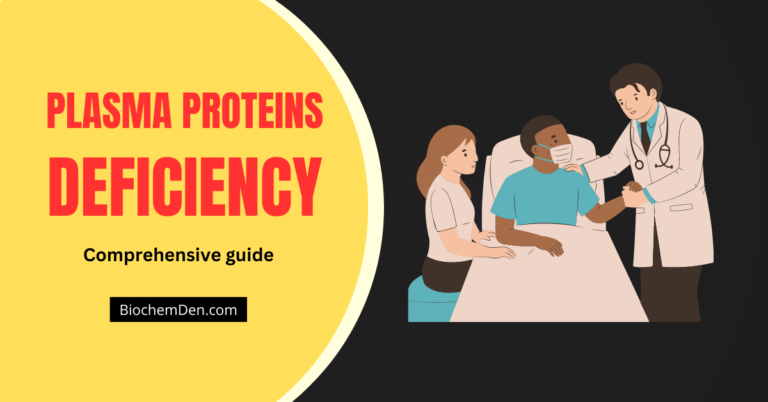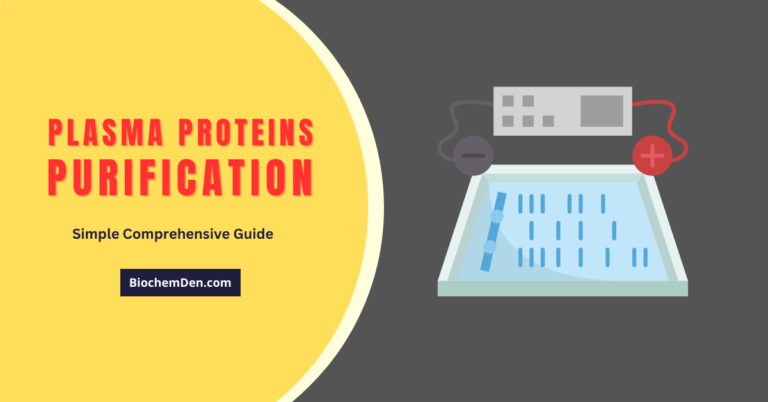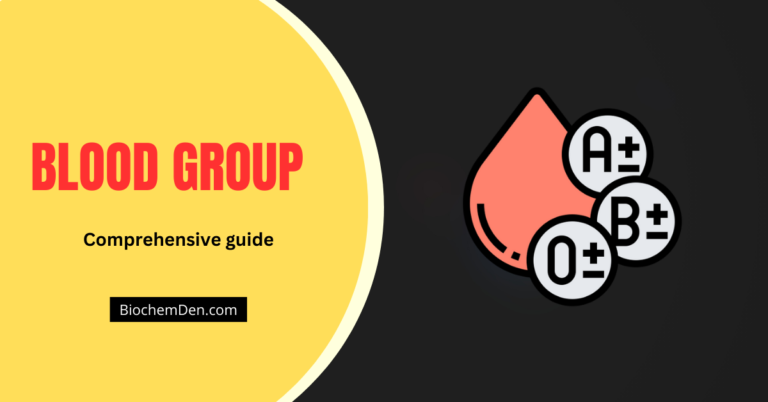Blood plasma contains 8% solids, which has 7% albumin. The different plasma proteins are albumins, globulins, and fibrinogen. Usually, total plasma proteins are 6 to 8 gms / 100 ml with albumin, and the globin ratio is 1.7:1.

The proteins present in human blood plasma are a mixture of simple proteins, glycoproteins, lipoproteins, and other conjugated proteins called “Plasma Protein. “Salt precipitation, immunological techniques, and electrophoresis may separate these.
Types of Plasma Proteins
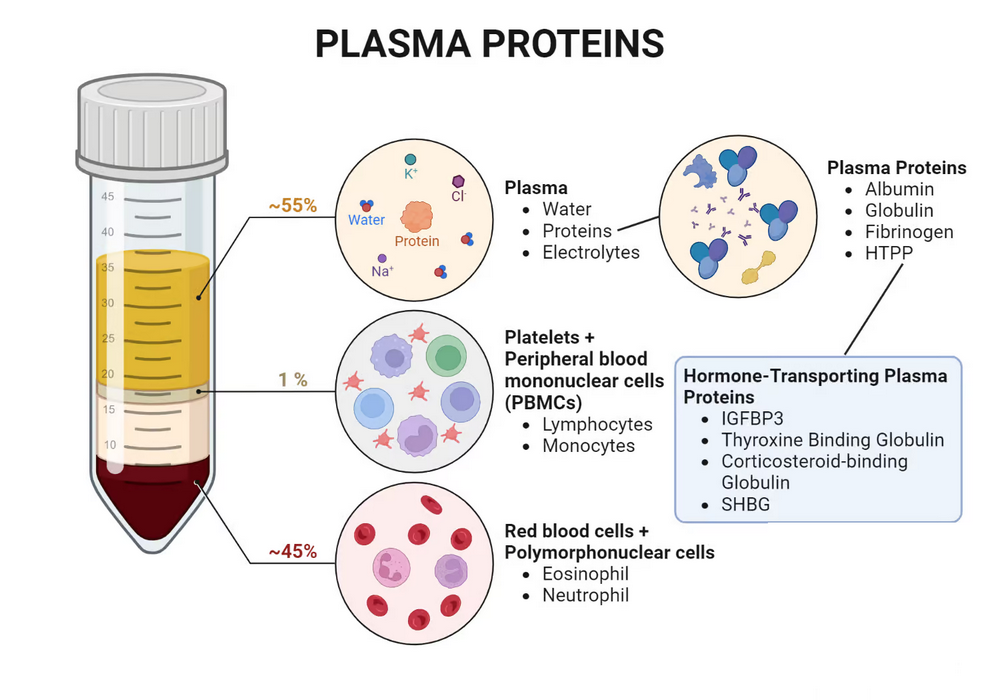
The three significant plasma protein fractions are albumin, globulin, and fibrinogen. For a more satisfactory resolution by electrophoresis, these fractions are separated as follows:
- Albumin – 55.2%
- α1-Globulin – 5.3% (α1-Antitrypsin, TBG, Transcortin, etc.)
- α2-Globulin – 8.6% (Haptoglobulin, ceruloplasmin, α2- macroglobulin, etc.)
- β-Globulin – 13.4% (β1-transferrin, β-lipoprotein, etc)
- ¥-Globulin – 11.0% (Antibodies, etc.)
- Fibrinogen – 6.5%
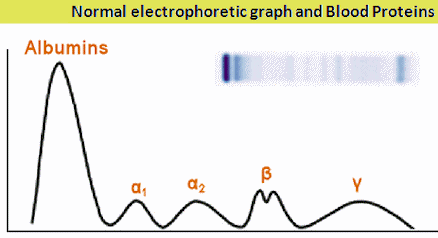
1. Albumin
It is the most abundant class of plasma protein (2.8 to 4.5 gm/100 ml) with the highest electrophoretic mobility. It is soluble in water and is precipitated by fully saturated ammonium sulfate. Albumin is synthesized in the liver and consists of a single polypeptide chain of 610 amino acids with a molecular weight of 69,000. The serum albumin consists of essential amino acids such as lysine, leucine, valine, phenylalanine, threonine, arginine, and histidine. The acidic amino acids like aspartic acid and glutamic acid are also concentrated in albumin.
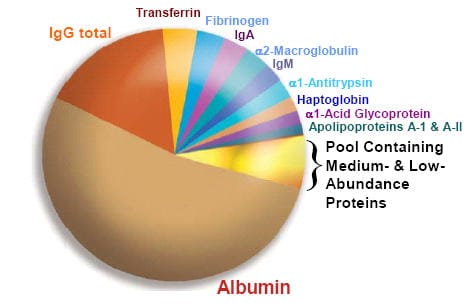
These residues make the molecule highly charged with a positive and negative charge. Besides having a nutritional role, albumin acts as a transport carrier for various biomolecules such as fatty acids, trace elements, and drugs. Another important function of albumin is maintaining osmotic pressure and fluid distribution between the blood and tissues.
- What is Amino acid and its Structural Chemistry?
- Protein Fundamental molecules are Amino acids
- Whey Proteins are Very Important? How to Explain?
2. Globulins
By electrophoresis, plasma globulins are separated into α1, α2, β, and ¥-globulins. These proteins are synthesized in the liver, whereas ¥-globulins are formed in the cells of the reticuloendothelial system. The average normal serum globulin (total) concentration is 2.5 gm/100 ml (Howe method) or 3.53 gm/100 ml by electrophoresis.
a. α1-Globulin
This fraction includes several complex proteins containing carbohydrates and lipids. These are orosomucoid, α1-glycoprotein, and α-lipoproteins. The normal serum level of α1-globulin is 0.42 gm/100 ml. Orosomucoid is rich in carbohydrates, is water-soluble, heat-stable, and has a molecular weight of 44,000. It serves to transport hexosamine complexes to tissues. Lipoproteins are soluble complexes that contain non-covalently bound lipids. These proteins act mainly as transport carriers for different lipids in the body.
b. α2-Globulins
This fraction also contains complex proteins such as α2-glycoproteins, plasminogen, prothrombin, haptoglobin, ceruloplasmin (transports Cu), and α2-macroglobulin. The normal serum value of this fraction is 0.67 gm/100 ml. Plasminogen and prothrombin are the inactive precursors of plasmin and thrombin, respectively, and both of these proteins play an important role in blood clotting.
Haptoglobulins are also glycoproteins with a molecular weight of 85,000. These are synthesized in the liver and can bind with any free hemoglobin that may arise in the plasma due to erythrocytes’ lysis, thus preventing the excretion of Hb and iron associated with it. Ceruloplasmin is a glycoprotein synthesized in the liver and is an essential component of copper metabolism in the body. Nearly 95% of plasma copper is bound to this protein.
c. β-Globulins
This fraction of plasma protein contains these different β-lipoproteins, which are very rich in lipid content. It also has transferrin (siderophilin), which transports non-heme iron in plasma. The normal serum value of β-globulins is 0.91 gm/100 ml. Transferrin is an iron transport protein, and it can be saturated with iron up to 33% in plasma. It has a low content of carbohydrates.
d. ¥-Globulins
These are also called Immunoglobulins and have antibody activity. Based on their electrophoretic mobility, they are classified as IgG, IgA, and IgM. Immunoglobulins are clinically significant components of globulins and are concerned with “immunological reactions.” Lymphocytes from these. Two different types of lymphocytes involved with immunoglobulin formation are “T-cells of Thymus” and “B-Cells” that originate from “bone marrow.”
3. Fibrinogen
It is a fibrous protein with a molecular weight of 340,000. It has six polypeptide chains which are held together by disulfide linkages. Thrombin converts fibrinogen into fibrin, which plays a vital role in the clothing of the blood. In addition to the proteins mentioned above, the plasma contains many enzymes, such as acid phosphatase and alkaline phosphatase, which have significant diagnostic value.
4. Hormone Transporting Plasma Proteins (HTPP)
Hormones are transported through the bloodstream by specialized plasma proteins. These proteins act as carriers that bind to specific hormones and transport them to target tissues. Several important hormone transport proteins include sex hormone-binding globulin (SHBG), corticosteroid-binding globulin (CBG), and thyroid hormone-binding globulin (TBG).
SHBG binds and transports testosterone and estradiol. CBG binds and carries glucocorticoids like cortisol. TBG transports thyroid hormones T3 and T4. These transport proteins regulate the amount of free or unbound hormone that is available to enter cells and cause effects.
They also prolong the half-life of hormones in circulation. The concentrations of hormone transport proteins can impact hormone signaling and cause issues if they are abnormal.
For example, excess SHBG reduces free testosterone availability while low TBG increases free thyroid hormones. Understanding these transport mechanisms is important for regulating hormone delivery and action.
- Plasma Protein Purification: A Comprehensive Guide
- Plasma Protein Deficiency: Symptoms, Causes, Diagnosis, and Treatment
Functions of Plasma Proteins
Plasma proteins are a crucial component of blood that perform many functions in the human body. They are produced in the liver and circulate in the blood, which is vital in maintaining our overall health. In this article, we will explore the functions of plasma proteins in detail.
Plasma protein is vital in our body. Here are the primary functions.
a. Protein Nutrition
It acts as a source of protein for the tissues whenever the need arises.
b. Osmotic pressure and water balance
The most abundant plasma protein in the blood is albumin, which plays a crucial role in maintaining fluid balance in the body. Albumin helps to regulate the amount of fluid in the blood vessels, preventing excessive fluid build-up in the tissues. It creates an oncotic pressure, which draws fluid back into the blood vessels. It prevents fluid from accumulating in the tissues, which can lead to edema, a condition where excess fluid builds up in the body.
Albumin is also involved in maintaining blood pressure. It helps to prevent a drop in blood pressure by regulating the amount of fluid in the blood vessels. When there is a decrease in blood volume, albumin draws fluid back into the blood vessels, which helps to maintain blood pressure.
- It exerts an osmotic pressure of about 25 mm Hg and plays an essential role in maintaining a proper water balance between the tissues and blood.
- Plasma albumin is mainly responsible for this function due to its low molecular weight and quantitative dominance over other proteins.
- During protein loss from the body, as in kidney diseases, an excessive amount of water moves into the tissues, producing edema.
c. Immune function
Plasma proteins play a crucial role in the immune system. Globulins are the primary type of plasma protein involved in immune function, as they help to fight off infections and diseases. There are three types of globulins – alpha, beta, and gamma – and each has a unique function.
Alpha and beta globulins transport and bind various substances in the blood, such as metal ions and lipids. They also play a role in the immune system by recognizing and attacking foreign invaders, such as bacteria and viruses.
Gamma globulins, also known as immunoglobulins, are the antibodies produced by the immune system in response to an infection or disease. They recognize and neutralize foreign invaders, such as bacteria and viruses, helping to prevent the spread of infection.
d. Buffering action
Plasma proteins help maintain the body’s pH by acting as ampholytes. At normal blood pH, they act as acids and accept captions.
e. Transport of Lipids
- One of the essential functions of plasma proteins is to transport lipids and lipid-soluble substances throughout the body.
- Fatty acids and bilirubin are transported mainly by Albumin, whereas cholesterol and phospholipids are carried by the lipoproteins present in β-globulins also transport fat-soluble vitamins (A, D, K, and E)
f. Transport of other substances
Plasma proteins transport various substances in the blood, including hormones, drugs, and fatty acids. Albumin is the primary carrier of fatty acids in the blood, transporting them to the cells where they are used for energy. It also transports some drugs, such as antibiotics and anticoagulants, in the blood to their target cells.
Globulins are involved in transporting substances as well. They are responsible for transporting hormones, such as thyroid and cortisol, in the blood to their target cells. They also transport metal ions, such as iron and copper, essential for many physiological processes.
- In addition to lipids, plasma proteins transport several metals and other substances. α2-Globulins transport copper (Ceruloplasmin), bound hemoglobin (haptoglobin), and thyroxine (glycoprotein), and non-heme iron is transported by transferrin present in the β-globulin fraction.
- Calcium, magnesium, some drugs and dyes, and several cations and anions are transported by plasma albumin.
g. Blood Coagulation
Fibrinogen is a plasma protein that plays a crucial role in blood clotting. When an injury or trauma occurs, fibrinogen is converted to fibrin, which forms a clot to stop bleeding. This process is essential for preventing excessive bleeding and promoting wound healing.
Fibrinogen works with other clotting factors in the blood, such as platelets and coagulation factors, to form a stable blood clot. It also helps to prevent blood clots from forming in the blood vessels, which can lead to serious health problems, such as stroke or heart attack.
Prothrombin is present in the α2-globulin fraction, and fibrinogen participates in blood clotting.
Prothrombin -> Thrombin (Presence–Thromboplastin)
Fibrinogen -> Fibrin (Clot) (Presence–Thrombin)
Frequently Asked Questions (FAQs)
How Are Plasma Proteins Separated?
The proteins are separated by using electrophoresis (mainly SDS-PAGE).
Describe How Blood Proteins Maintain Osmotic Balance?
The osmotic pressure of blood proteins=25mmHg (80% of the effect caused by albumin), so it is needed to maintain cell and interstitial fluid volume.
How Do Plasma Proteins Act As Buffers?
It can function as a buffer because it is responsible for 15% of the blood buffering potential (rest due to bicarbonate) and acts as a zwitterions dependent on pH.
Which Of The Following Plasma Proteins Is Necessary For Blood Clotting To Occur?
Fibrinogen is very important in the blood coagulation process.
What Plasma Protein Do In The Blood, And What Percent Do They Make Up?
They mediate the transport of lipids, hormones, vitamins, and metals and engage in immune surveillance, protease inhibitors, complement, and clotting proteins. It makes up 7% of the plasma.
What plasma protein is essential in body defense?
| Blood Proteins | Normal level | % | Function |
| Albumins | 3.5-5.0 g/dl | 55% | create and maintain oncotic pressure; transport insoluble molecules |
| Globulins | 2.0-2.5 g/dl | 38% | participate in the immune system |
| Fibrinogen | 0.2-0.45 g/dl | 7% | Blood coagulation |
| Regulatory proteins | <1% | Regulation of gene expression | |
| Clotting factors | <1% | Conversion of fibrinogen into Fibrin |
How much plasma protein in blood?
The protein level in Blood plasma is given below
| PLASMA PROTEIN | NORMAL RANGE (mg/dL) |
| Albumin | 3,500 – 4,500 |
| Prealbumin (Transthyretin) | 10 – 40 |
| α1-Globulins | 300 – 600 |
| α1 Acid Glycoprotein (orosomucoid) | 55 – 140 |
| α-Fetoprotein | approx. 0.001 |
| Retinol Binding Protein | 3 – 6 |
| Thyroxine Binding Globulin | 1 – 2 |
| Transcortin | 3 – 3.5 |
| α2 Globulins (excluding lipoproteins) | 400 – 900 |
| Ceruloplasmin | 15 – 60 |
| Haptoglobin Type 1-1 | 100 – 220 |
| Haptoglobin Type 2-1 | 160 – 300 |
| Haptoglobin Type 2-2 | 120 – 260 |
| α2 Macroglobulin | 100 – 280 |
| β-Globulins (excluding lipoproteins) | 600 – 1,100 |
| C-Reactive Protein | < 1 |
| Hemopexin | 50 – 100 |
| β2 Microglobulin | approx. 0.2 |
| Transferrin | 200 – 320 |
| γ-Globulins | 700 – 1,500 |
Final words
plasma proteins are an important component of blood that perform a wide range of functions in the human body. They help to maintain fluid balance, transport various substances in the blood, play a crucial role in the immune system, and are involved in blood clotting.
Understanding the functions of plasma proteins is important for maintaining our overall health and appreciating the complexity of the human body. With ongoing research and understanding of the role of plasma proteins, we can continue to improve our knowledge of the human body and how to keep it healthy.
It is clear that plasma proteins are essential for our survival and health, and we must ensure that we take good care of our bodies to maintain optimal levels of these vital proteins.
Source: Serum Protein Fractions
Discover more from Biochemistry Den
Subscribe to get the latest posts sent to your email.



